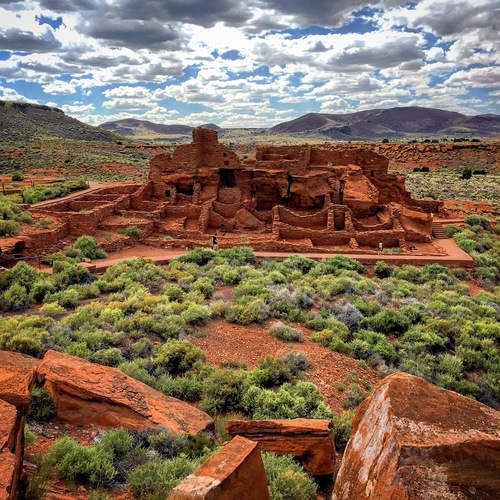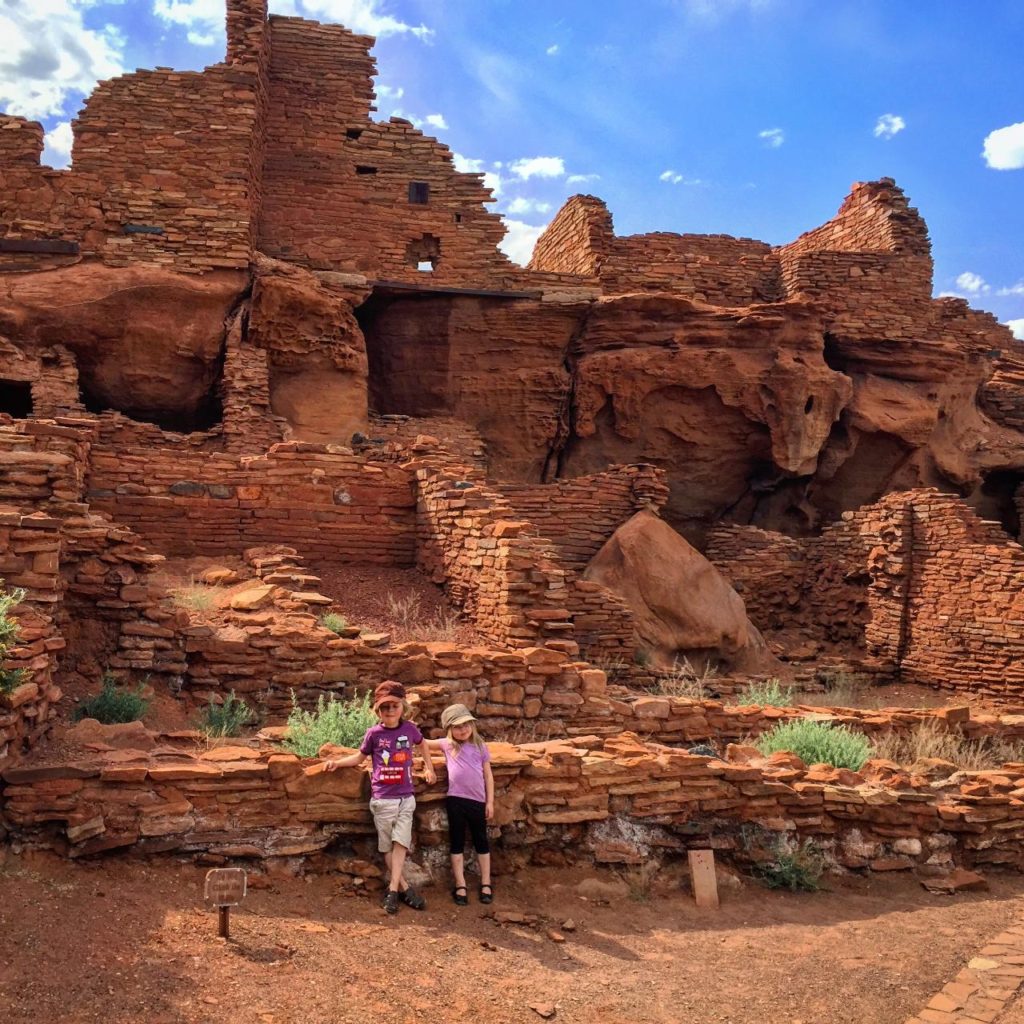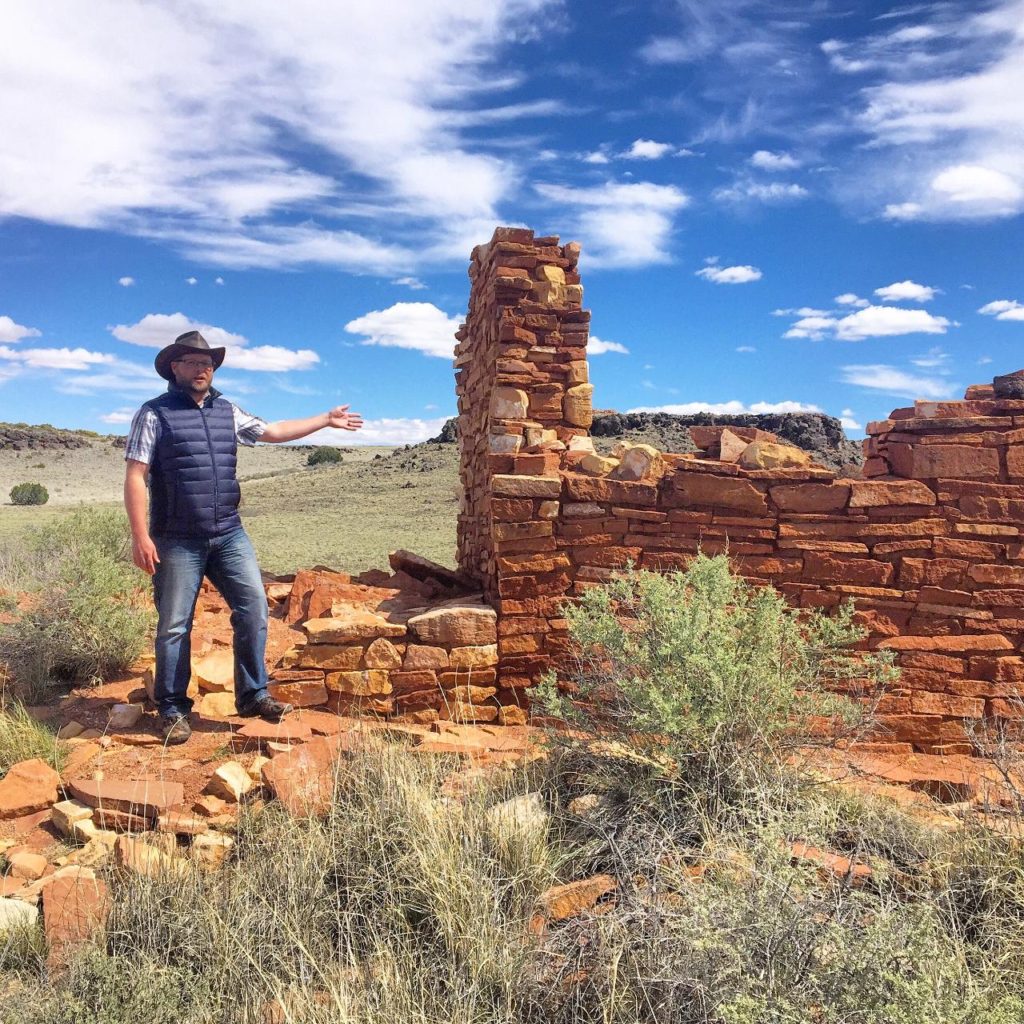WUPATKI NATIONAL MONUMENT • FLAGSTAFF, ARIZONA
Nate Loper – April 11, 2023
The history of the Wupatki National Monument is rich and complex, preserving several ruins and artifacts that offer a glimpse into the lives and culture of the Ancestral Puebloans who inhabited the region over 800 years ago.
 Nestled in the desert landscapes of northern Arizona lies a fascinating destination that takes visitors back in time to the ancient world of the Puebloan people. Wupatki National Monument, located just north of Flagstaff, is a collection of ruins, petroglyphs, and geological formations that provide a glimpse into the lives and culture of the people who inhabited the area over 800 years ago.
Nestled in the desert landscapes of northern Arizona lies a fascinating destination that takes visitors back in time to the ancient world of the Puebloan people. Wupatki National Monument, located just north of Flagstaff, is a collection of ruins, petroglyphs, and geological formations that provide a glimpse into the lives and culture of the people who inhabited the area over 800 years ago.
The Wupatki National Monument covers over 35,000 acres of land and preserves several ancient Puebloan ruins, including Wupatki Pueblo, Lomaki Pueblo, Wukoki Pueblo, and several other smaller structures. The monument is managed by the National Park Service, which works to protect and preserve the unique history and natural beauty of the area.
THE SINAGUA ANCESTRAL PUEBLOANS
The people group who lived here are known as the Sinagua, a play on the Spanish words “sin aqua”, meaning “without water”, as early ethnologists and archaeologists noted the landscape bears little to no surface water. What water was used by the Sinagua was collected from rainwater, a few springs, and the ephemeral Little Colorado River, which was around 7-10 miles away from most of the major sites here.
The Sinagua are part of the Uto-Aztecan people group, and are believed to be the ancestors of today’s nearby Hopi people. They are also related to the widespread “Anasazi” of the 4-Corners region of the American Southwest, though that term Anasazi is rarely used today, as it comes from the Navajo Diné people and is often translated as “ancient enemy”. As such, it’s a term that has fallen out of favor within the park service and many people involved in archaeology and anthropology studies.
The term used by the Hopi for their ancestors is Hisatsinom, meaning “ancient ones”. In order to geographically define the specific Ancestral Puebloan people group once living in Wupatki and the nearby Flagstaff area, the term used most remains Sinagua. These Sinagua Ancestral Puebloans were skilled farmers, architects, and craftsmen who built impressive structures and created intricate pottery, jewelry, and textiles.
 WUPATKI PUEBLO
WUPATKI PUEBLO
One of the most impressive structures in the monument is the Wupatki Pueblo, a multi-story building constructed of red Moenkopi Sandstone that served as a cultural and economic center of the region. The pueblo is believed to have been built around 1100 CE and housed over 100 rooms and multiple kivas, or ceremonial chambers. The Wupatki Pueblo was likely home to several families and was used for various ceremonies and gatherings.
Visitors to the monument can take guided tours of the Wupatki Pueblo and learn about the unique architectural techniques and cultural practices of the Ancestral Puebloans. In addition, The pueblo features several unique architectural elements, including a ball court that was used for various ceremonies and games. The ball court was likely used for social and religious events, and the size and complexity of the court suggest that it played an important role in the culture of the Ancestral Puebloans, and dozens are found throughout Arizona. The one at Wupatki remains the northernmost ballcourt of its type in America.
THE BLOWHOLE
One of the unique geological features at the Wupatki National Monument is the blowhole, a natural vent in the ground that releases air from an underground cave system. The blowhole is located in a small depression in the earth, now framed by masonry. On most days, visitors can feel the rush of cool moist air as it escapes from the underground caverns deep within the Kaibab Limestone.
The blowhole is thought by some to have been used by the Ancestral Puebloans for religious and ceremonial purposes, and it is still considered a sacred site by some Native American communities today. It’s a place where they say the earth “breathes”. The blowhole is just one of the many fascinating features that make the Wupatki National Monument such a special place to visit.
ACTIVITIES IN THE AREA
In addition to the ancient ruins, the Wupatki National Monument area offers a variety of trails both in the Monument as well as nearby on National Forest land including the Doney Mountain Trail, a popular hike that takes visitors to the top of Doney Mountain Volcano, where they can enjoy breathtaking views of the San Francisco Peaks and surrounding mesas in the Painted Desert.
The Wupatki National Monument is also home to a diverse range of wildlife and vegetation. Visitors can often spot a variety of animals, including pronghorn antelope, coyotes, rabbits, and lizards, as well as several species of birds.
HISTORY AND CULTURE
The history of the Wupatki National Monument is rich and complex, preserving several ruins and artifacts that offer a glimpse into the lives and culture of the Ancestral Puebloans who inhabited the region over 800 years ago.
The Wupatki Pueblo and other structures in the monument showcase the unique architectural techniques and cultural practices of the Ancestral Puebloans. The Sinagua people were known for their use of locally-sourced materials, including sandstone, volcanic rock, and adobe, which they used to build multi-story structures that could house entire families and communities.
 Visitors to the Wupatki National Monument can learn about the culture and history of the Ancestral Puebloans through a variety of interpretive programs and exhibits. The monument features a visitor center that offers interactive exhibits, videos, and ranger-led programs that provide insight into the lives and culture of the people who once inhabited the region.
Visitors to the Wupatki National Monument can learn about the culture and history of the Ancestral Puebloans through a variety of interpretive programs and exhibits. The monument features a visitor center that offers interactive exhibits, videos, and ranger-led programs that provide insight into the lives and culture of the people who once inhabited the region.
One of the most fascinating aspects of the Wupatki National Monument is its connection to other nearby cultural and historical sites, including Sunset Crater Volcano National Monument and the Grand Canyon. They were known for their extensive trade networks and connections to other communities across the Southwest, and the Wupatki National Monument offers a window into this complex web of cultural exchange and interaction.
WUPATKI GUIDED TOURS
We provide guided tours to Wupatki National Monument on our Full-Day Triple Park Tour that also visits Grand Canyon and Sunset Crater Volcano National Monument on this 11-hour adventure tour of geology, history, and archaeology.
Canyon Ministries also provides large group tours to Wupatki that can be combined with a multi-day tour experience in the Grand Canyon and Flagstaff areas.
Overall, the Wupatki National Monument is a must-visit destination for anyone interested in the history and culture of the Ancestral Puebloans and the natural beauty of the southwestern United States. Whether you’re interested in hiking, exploring ancient ruins, or learning about the rich history of the region, the monument offers something for everyone.




